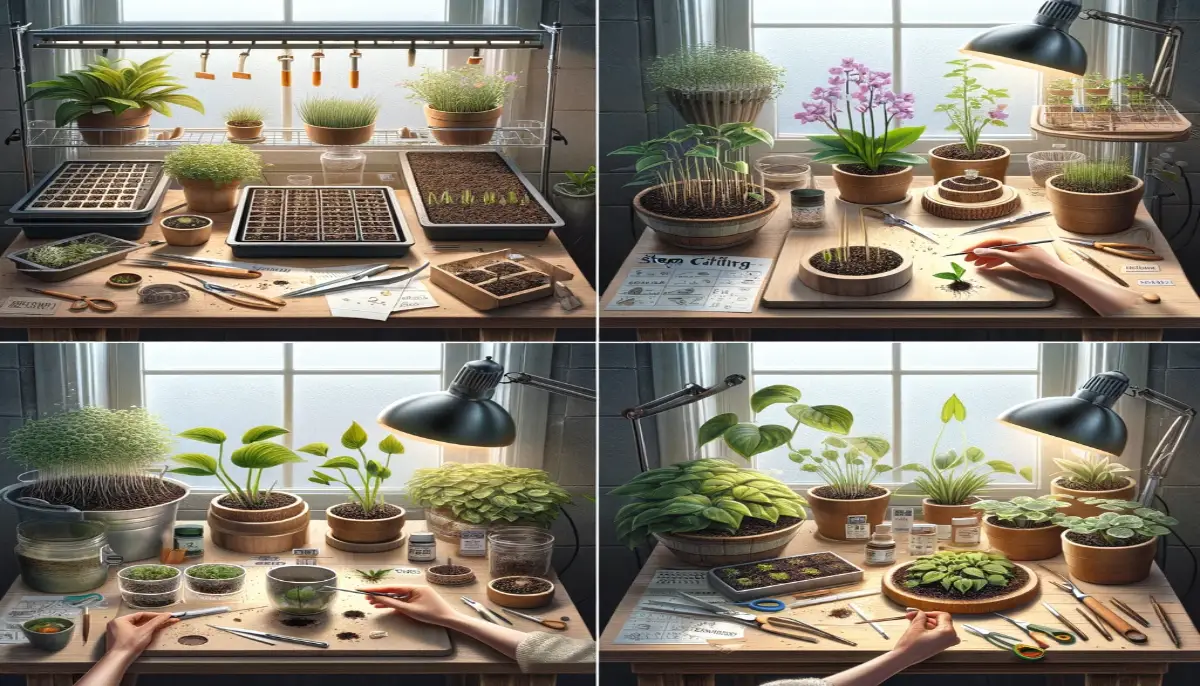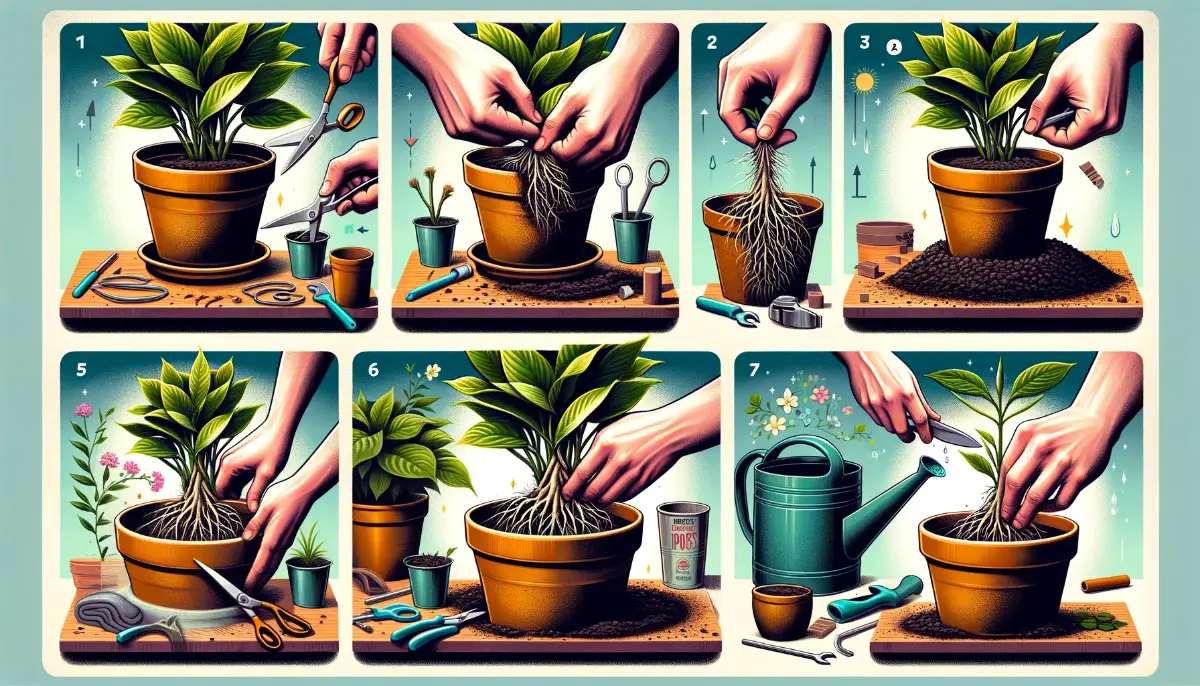Pruning is a crucial horticultural practice that involves selectively removing parts of a plant to enhance its health, appearance, and productivity.
While it might seem intimidating at first, understanding the basics and benefits of pruning can make this task a rewarding part of your gardening routine.
[zynith-toc]
Importance of Pruning
Pruning serves multiple important functions in plant care:
- Promotes Plant Health: By removing dead, diseased, or damaged branches, pruning helps prevent the spread of disease and pests, ensuring the overall health of the plant.
- Encourages Growth: Proper pruning can stimulate new growth, leading to a fuller, more robust plant.
- Enhances Appearance: Pruning helps maintain the desired shape and size of a plant, contributing to its aesthetic appeal.
- Increases Yield: For fruiting and flowering plants, pruning can lead to more abundant and higher quality blooms and fruits.
Benefits of Pruning
The benefits of pruning extend beyond basic plant maintenance:
- Improved Air Circulation: Removing excess branches allows for better air circulation, reducing the risk of fungal diseases and promoting a healthier environment for the plant.
- Better Light Penetration: Pruning allows sunlight to reach deeper into the plant, ensuring that all parts of the plant receive adequate light for photosynthesis.
- Stronger Structure: Pruning helps develop a strong framework for plants, particularly young trees, which can withstand heavy winds and support more fruit.
- Longer Lifespan: Regular pruning can extend the life of your plants by keeping them vigorous and reducing stress.
Types of Plants Suitable for Pruning
Almost all types of plants benefit from some form of pruning, including:
- Flowering Plants: Roses, hydrangeas, and other flowering shrubs often require pruning to maintain their beauty and health.
- Fruit Trees: Apple, pear, citrus, and other fruit trees need regular pruning to maximize fruit production and prevent disease.
- Shrubs: Many ornamental shrubs, such as boxwoods and azaleas, benefit from shaping and thinning.
- Houseplants: Indoor plants like fiddle leaf figs and pothos can thrive with occasional pruning to control size and encourage bushier growth.
By understanding the importance and benefits of pruning, you can approach this task with confidence and ensure that your plants remain healthy and beautiful.
Definition of Pruning
Pruning is the practice of selectively removing parts of a plant, such as branches, buds, or roots, to improve the plant’s structure, health, and aesthetic appeal. This process can involve cutting back overgrown branches, thinning out dense foliage, or removing dead or diseased parts to encourage new growth and improve the overall shape of the plant.
Types of Pruning
There are several different types of pruning, each serving a specific purpose:
Thinning:
- Purpose: To remove entire branches or stems to improve light penetration and air circulation within the plant.
- Applications: Useful for overcrowded plants, trees, and shrubs.
Heading:
- Purpose: To shorten stems and branches to encourage bushier growth and more compact form.
- Applications: Commonly used for shaping and controlling the size of shrubs and small trees.
Rejuvenation:
- Purpose: To drastically cut back a plant to stimulate new, vigorous growth from the base or root system.
- Applications: Often used for overgrown or neglected shrubs to restore their form and vitality.
Tools Needed for Pruning
Having the right tools is crucial for effective and efficient pruning. Here are the essential tools you will need:
Pruning Shears (Hand Pruners):
- Use: Ideal for cutting small branches and stems up to ¾ inch in diameter.
- Types: Bypass pruners (for clean cuts) and anvil pruners (for tougher, woody stems).
Loppers:
- Use: Suitable for cutting branches up to 2 inches in diameter.
- Features: Long handles provide extra leverage, making it easier to cut thicker branches.
Pruning Saws:
- Use: Necessary for cutting branches thicker than 2 inches.
- Types: Folding saws, bow saws, and curved blade saws for different cutting needs.
Hedge Shears:
- Use: Designed for trimming and shaping hedges and bushes.
- Features: Long, straight blades for even cuts over a large surface area.
Pole Pruners:
- Use: Allow you to reach and cut high branches without a ladder.
- Features: Extendable handles and a combination of saw and pruner blades.
Protective Gear:
- Items: Gloves, safety glasses, and sometimes a hard hat for larger pruning jobs.
- Purpose: To protect yourself from sharp tools and falling debris.
Key Concepts
Cutting Angles:
- Make cuts at a 45-degree angle to prevent water from collecting on the cut surface, which can lead to rot and disease.
Cutting Position:
- Always cut just above a bud or side branch to encourage new growth in the desired direction.
Sanitizing Tools:
- Clean and sterilize your tools before and after use to prevent the spread of disease between plants.
By mastering these basics, you’ll be well-prepared to begin pruning your plants, ensuring they remain healthy, attractive, and productive.
When to Prune
Timing is crucial when it comes to pruning, as it can significantly affect the health and growth of your plants.
Spring Pruning:
- Best For: Most deciduous trees and shrubs, early-flowering plants (pruned after blooming).
- Purpose: Remove winter damage, shape plants, and encourage vigorous spring growth.
- Considerations: Avoid pruning spring-flowering plants until after they bloom to prevent removing flower buds.
Summer Pruning:
- Best For: Controlling growth, shaping plants, and removing spent flowers.
- Purpose: Manage plant size, remove water sprouts and suckers, and encourage flowering and fruiting.
- Considerations: Prune lightly to avoid stressing the plant during hot weather.
Fall Pruning:
- Best For: Cleaning up the garden and preparing plants for winter.
- Purpose: Remove dead or diseased branches, and thin dense growth.
- Considerations: Avoid heavy pruning as it can stimulate new growth that is vulnerable to winter damage.
Winter Pruning:
- Best For: Dormant trees and shrubs, particularly those that flower in late spring or summer.
- Purpose: Shape plants, remove crossing branches, and encourage healthy spring growth.
- Considerations: Prune during dormancy to minimize stress and prevent sap bleeding.
Plant-Specific Timing
Different plants have unique pruning needs and optimal times for pruning to ensure their health and productivity.
Flowering Plants:
- Spring-Flowering Plants: Prune immediately after blooming (e.g., forsythia, lilac).
- Summer-Flowering Plants: Prune in late winter or early spring before new growth begins (e.g., butterfly bush, hydrangea).
Fruit Trees:
- Apples and Pears: Prune in late winter while the trees are dormant.
- Citrus Trees: Prune in early spring after the danger of frost has passed.
Shrubs:
- Deciduous Shrubs: Prune in late winter or early spring before new growth.
- Evergreen Shrubs: Prune in early spring for shape and size control, with minor pruning throughout the year as needed.
Houseplants:
- Foliage Plants: Prune year-round as needed to control size and remove dead or yellowing leaves.
- Flowering Houseplants: Prune after blooming to encourage new growth and more blooms.
Common Mistakes to Avoid
Pruning can significantly benefit your plants when done correctly, but it can also harm them if not done properly. Here are some common mistakes to avoid to ensure successful pruning.
Over-Pruning
Definition: Removing too much of the plant’s foliage or branches at once.
Consequences: Can stress the plant, reduce its ability to photosynthesize, and make it more vulnerable to disease and pests.
Avoidance Tips:
- Only remove up to one-third of a plant’s foliage in a single pruning session.
- Prune regularly but lightly, rather than heavily and infrequently.
Incorrect Timing
Definition: Pruning at the wrong time of year for the specific plant species.
Consequences: Can lead to loss of flowers, reduced fruit production, or damage to the plant.
Avoidance Tips:
- Research the best pruning times for each plant species you have.
- Follow seasonal and plant-specific guidelines for pruning.
Using Dull Tools
Definition: Pruning with blades that are not sharp.
Consequences: Can cause ragged cuts that increase the risk of disease and slow the healing process.
Avoidance Tips:
- Regularly sharpen your pruning tools.
- Use clean, well-maintained tools for each pruning session.
Cutting Too Close to the Bud
Definition: Making cuts too close to a bud or growing point.
Consequences: Can damage the bud, preventing new growth from developing properly.
Avoidance Tips:
- Leave a small stub of about ¼ inch above the bud to protect it.
- Make angled cuts away from the bud to direct water away and promote healthy growth.
Not Removing Dead or Diseased Wood
Definition: Failing to remove branches that are dead, diseased, or damaged.
Consequences: Can lead to the spread of disease and pests, and hinder the plant’s overall health.
Avoidance Tips:
- Regularly inspect plants for dead or diseased wood.
- Remove any unhealthy branches immediately to prevent further issues.
Making Incorrect Cuts
Definition: Making improper cuts, such as leaving stubs or cutting flush to the trunk.
Consequences: Can lead to poor wound healing and increase the risk of disease.
Avoidance Tips:
- Make clean, angled cuts just outside the branch collar (the swollen area where the branch meets the trunk).
- Avoid cutting too close or leaving long stubs.
Ignoring Plant Structure and Growth Habits
Definition: Pruning without considering the natural shape and growth pattern of the plant.
Consequences: Can result in an unnatural appearance and unbalanced growth.
Avoidance Tips:
- Study the natural growth habits of your plants.
- Prune to enhance the plant’s natural form rather than forcing it into an unnatural shape.
Aftercare
After pruning your plants, proper aftercare is essential to ensure their health and encourage vigorous growth.
Watering After Pruning
Importance: Pruning can stress plants, and adequate water helps them recover and promotes new growth.
Tips:
- Water the plant thoroughly after pruning to help it recover.
- Ensure the soil is evenly moist but not waterlogged.
- For drought-tolerant plants, adjust watering according to their specific needs.
Fertilizing
Purpose: Provides essential nutrients to support the plant’s recovery and stimulate new growth.
Tips:
- Apply a balanced fertilizer (e.g., 10-10-10) after pruning to encourage healthy growth.
- For flowering and fruiting plants, use a fertilizer higher in phosphorus (middle number) to promote blooms and fruit production.
- Follow the manufacturer’s instructions for the correct application rate.
Mulching
Purpose: Helps retain moisture, regulate soil temperature, and suppress weeds.
Tips:
- Apply a 2-3 inch layer of organic mulch (e.g., bark, compost, or straw) around the base of the plant.
- Keep the mulch a few inches away from the plant’s trunk or stems to prevent rot.
- Replenish mulch as needed to maintain its effectiveness.
Monitoring for Pests and Diseases
Importance: Pruning can create entry points for pests and diseases.
Tips:
- Regularly inspect the plant for signs of pests or diseases.
- Treat any infestations or infections promptly with appropriate organic or chemical controls.
- Ensure good air circulation around the plant to reduce the risk of fungal diseases.
Supporting New Growth
Purpose: Helps guide and support the new growth that results from pruning.
Tips:
- Provide stakes or supports for plants that may need help maintaining their structure (e.g., tall perennials or newly pruned trees).
- Train new growth by gently tying branches to supports as needed.
- Prune any weak or crossing branches that develop to maintain a strong structure.
Continued Maintenance
Purpose: Ensures the long-term health and appearance of the plant.
Tips:
- Perform light maintenance pruning throughout the growing season to remove any dead or damaged growth.
- Regularly check the plant’s overall health and make adjustments to care as needed (e.g., watering, fertilizing, pest control).
- Plan for future pruning sessions based on the plant’s growth and seasonal needs.
FAQs about Pruning Plants
When is the best time to prune my plants?
The best time to prune depends on the type of plant. Generally, late winter or early spring is ideal for most plants. However, spring-flowering plants should be pruned right after they bloom, and summer-flowering plants should be pruned in late winter or early spring.
Can I prune my plants in the summer?
Yes, you can perform light pruning in the summer to control growth and shape your plants. However, avoid heavy pruning during hot weather, as it can stress the plant.
How much of the plant should I prune at one time?
As a general rule, do not remove more than one-third of a plant’s foliage at one time. Over-pruning can stress the plant and reduce its ability to photosynthesize.
What should I do with the branches and leaves I cut off?
The pruned material can be composted if it is free of disease and pests. Otherwise, dispose of it properly to prevent the spread of disease.
How do I know if my pruning tools are sharp enough?
Sharp tools should make clean, smooth cuts without crushing or tearing the plant tissue. If the cuts are jagged or require excessive force, it’s time to sharpen or replace your tools.
What are the signs that a plant needs pruning?
Signs include dead or diseased branches, overgrown or dense growth, crossing branches, and reduced flowering or fruiting. Regular pruning helps maintain plant health and appearance.
Can I prune my houseplants?
Yes, houseplants can be pruned to control size, remove dead or yellowing leaves, and encourage bushier growth. Prune as needed throughout the year.
What is the difference between thinning and heading cuts?
Thinning cuts remove entire branches back to their point of origin, improving light penetration and air circulation. Heading cuts shorten branches to a bud, promoting bushier growth.
How can I avoid spreading diseases when pruning?
Clean and sterilize your pruning tools before and after use, especially when moving between plants. Use a solution of one part bleach to nine parts water or rubbing alcohol for sterilization.
What should I do if I make a wrong cut?
If you make an incorrect cut, don’t panic. Clean up the cut by making a proper one just above a bud or branch collar. Plants are resilient and will often recover from minor pruning mistakes.










